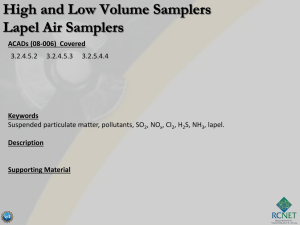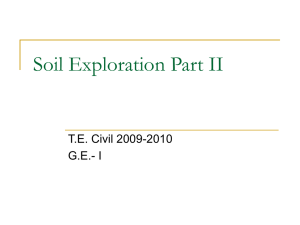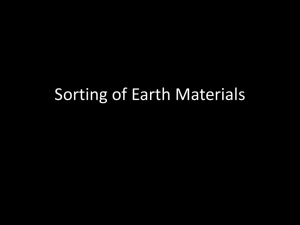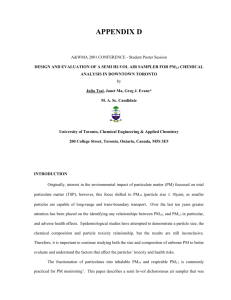Ambient Monitoring
advertisement
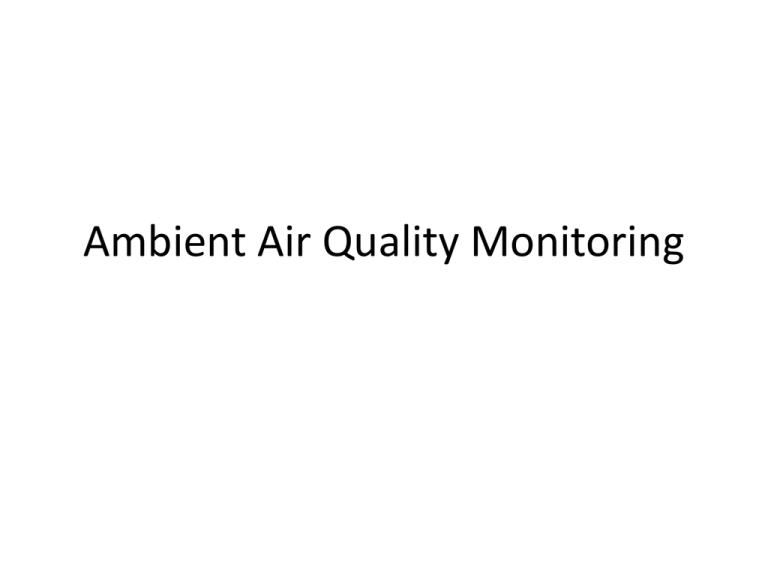
Ambient Air Quality Monitoring 本章內容 • Sampling and analysis of ambient air (環境大 氣採樣與分析) – particulate – Gases • Monitoring network for ambient air quality (空氣品質監測系統) – 監測目的 – 監測站網的種類 – 監測站設計 – 監測站資料分析與應用 Inhalable, thoracic, and respirable particles, which describe where particles are likely to deposit in the lung, are terms used more commonly in industrial hygiene (occupational-related PM exposures), while PM2.5 and PM10 are terms used by EPA to describe particles up to 2.5 μm and up to 10 μm, respectively. These EPA size fractions are also described with the terms “coarse” (10 μm – 2.5 μm) and “fine” (<2.5 μm). Exposure to large particles can cause coughing and sneezing, while smaller particles can bypass the body’s defense mechanisms and disrupt cellular processes. Source: USEPA, APTI 435, Atmospheric Sampling Course student manual. Particulate Matter • Suspended particulate matter (SPM) or total suspended particulate (TSP) in air generally is a complex, multi-phase system of all airborne solid and low-vapor pressure liquid particles having aerodynamic particle sizes from below 0.01 μm to 100 μm and larger. • Inhalable PM is the fraction of suspended particulate matter (SPM) that is capable of being respired into the human respiratory system in significant quantities, described as particles with an aerodynamic diameter of less than 10 μm (i.e., PM10). This size fraction is more commonly referred to as coarse particles or thoracic coarse particles. • Respirable PM is the subset of SPM includes a size fraction of particles with an aerodynamic diameter of the less than 2.5 μm. The smaller particles (PM2.5) are able to reach the lower regions of the human respiratory tract and, thus, are responsible for most of the adverse health effects associated with suspended particulate pollution. This size fraction is more commonly referred to as fine particles. Source: USEPA, APTI 435, Atmospheric Sampling Course student manual., p5-1 Atmospheric particles • Atmospheric particles can be identified based on the two distinct modes in which they occur: the fine (<2.5 μm) mode and the coarse (2.5-10.0 μm) mode. • The fine or accumulation mode (or respirable particulate matter) is attributed to the growth of particles from the gas phase and subsequent agglomerization. • The coarse mode is made of mechanically abraded or ground particles. • Because of their initially gaseous origin, the fine range of particle sizes includes inorganic ions such as sulfate, nitrate, and ammonia, as well as combustion-form carbon, organic aerosols, metals, and other combustion products. Coarse particles, on the other hand, normally consist of finely divided minerals such as oxides of aluminum silicate, iron, calcium, and potassium. Source: USEPA, APTI 435, Atmospheric Sampling Course student manual., p5-2 Dustfall Bucket or Jar(落塵筒) • The dustfall bucket had been one of the earliest sampling devices for particulate matter in the atmosphere. Although not widely used by EPA anymore, this method was used extensively in the early days of air monitoring and is still used throughout the world. The bucket or jar was made of resistant material and often placed in a stand to prevent the container from spilling. A wire rim was used to prevent the container from collecting bird droppings. The dustfall bucket is used mostly as a bulk collector for wet (rainwater) and dry (dust) deposition. Results were calculated by filtering the liquid, with subsequent weighing of the remaining solids. Source: USEPA, APTI 435, Atmospheric Sampling Course student manual., p5-2 Hi-vol sampler The so-called high-volume (hi-vol) sampler for total suspended particulate matter (TSP) was previously the most widely used sampler since it was the Federal Reference Method (FRM) for measuring compliance with the TSP particulate matter standard. Hi-vol sampler components (motor, filter, housing). Source: USEPA, APTI 435, Atmospheric Sampling Course student manual. Hi-vol sampler in shelter Source: USEPA, APTI 435, Atmospheric Sampling Course student manual. Air flow of hi-vol sampler in shelter The shelter must provide protection for the sampler, and at the same time allow unrestricted access of ambient air from all directions without direct impingement of particles on the filter. A high-volume sampler with a 7- by 9-inch exposed filter area operated in a standard shelter at a sampling flow rate of 1.1 to 1.7 cubic meters per minute collects particles of up to 25 to 50 μm in aerodynamic diameter, depending on wind speed and direction, and uniformly distributes the sample over the filter surface. Source: USEPA, APTI 435, Atmospheric Sampling Course student manual. Hi-vol sampler filter adapter assembly Hi-vol filter cartridge Source: USEPA, APTI 435, Atmospheric Sampling Course student manual. flow rate indicating devices: Most high-volume samplers use an orifice/pressure indicator, an electronic mass flowmeter, or a rotameter (visifloat) for measuring sampling flow rate Source: USEPA, APTI 435, Atmospheric Sampling Course student manual. Flow Rate Device Calibration: All flow rate measuring devices must be calibrated against known flow rates. This is accomplished by calibrating the devices with a flow rate transfer standard that has been calibrated with a positive-displacement standard volume meter having a calibration that is traceable to the National Institute of Standards and Technology. Flow rate transfer standard calibration setup Source: USEPA, APTI 435, Atmospheric Sampling Course student manual. Analysis of High-Volume Filters Filters from hi-vol samplers can be analyzed much more thoroughly than by just simple mass concentration determination. After a filter has been weighed, it can be cut into sections for subsequent analysis. Destructive extraction techniques that might be used in preparing the filter for analysis are organic solvent extraction, acid extraction, and aqueous extraction. To determine the amount of organic aerosol present in the ambient air, organics on a portion of a filter can be extracted with an organic solvent, such as chloroform, in conjunction with a Soxhlet ® extractor. The resulting organic fraction can then be analyzed by appropriate techniques, such as infrared or ultraviolet spectrometry. Metals can be extracted from the particulate matter of a portion of a high-volume filter by placing the filter portion in an acid solution. Any filter matter that disintegrates in the acid can be removed by centrifugation. After extraction, the resulting soluble metal solution can be analyzed by a number of methods, including atomic absorption spectrophotometry, atomic emission spectroscopy, polarography, and inductively coupled plasma emission spectroscopy. Water-soluble species (such as sulfates and nitrates) of the particulate matter of a high-volume filter can be extracted using deionized, distilled water. The resulting solution can then be analyzed using methods such as ultraviolet or visible spectrometry. PM10 measurement In the FRM for PM10, an air sampler draws ambient air at a constant flow rate into a specially shaped inlet where the suspended particulate matter is inertially separated into one or more size fractions within the PM10 size range. Each size fraction in the PM10 size range is then collected on a separate filter over the specified sampling period. Two types of samplers that meet EPA FRM designation for PM10 requirements are the high-volume (1000 L/min) PM10 sampler and the dichotomous sampler (16.7 L/min). Inertial Collection Inertial collectors are designed to give a size-representative sample of particles in the atmosphere. A particle moving in an air stream with approximately the same velocity as the air stream has more momentum (mass X velocity) than the volume of air that it displaces because of its higher mass. The momentum, or inertia, possessed by a particle in a moving air stream will cause the particle to be deflected less than the air in the vicinity of the particle when the air stream undergoes a sudden change in direction. Such a deflection will occur when an obstacle is placed directly in the path of an aerosol stream. If the resulting deflection of the particle from the air trajectory around the obstacle is great enough (large angle of deflection), the particle will strike the obstacle. High incident velocities will increase the momentum of particles in the air stream, thereby enhancing their removal. High velocities can be attained by passing the air stream through an orifice (jet) prior to the stream striking the obstacle. Source: USEPA, APTI 435, Atmospheric Sampling Course student manual. Schematic diagram of an impaction inlet Virtual Impactor In the virtual impaction method, instead of the larger particles impacting onto a solid collection surface, they impact into a slowly pumped void and are later collected on a filter downstream. Thus, these larger particles impact through a non-existent void, or virtual surface. As depicted in the figure, the smaller (fine) particles follow the streamlines of the faster flow (Ff); the larger (coarse) particles are impacted into the slower flow (Fc). A small fraction of the fine particles is impacted and collected with the coarse particles. This can be mathematically corrected when determining fine and coarse particulate concentrations. Virtual Impactors— Dichotomous Sampler Virtual Impactors— Dichotomous Sampler PM2.5 Inertial Particle Size Separator EPA’s Federal Reference Method or Federal Equivalent Method (FRM or FEM) sampler for PM2.5 provides for the measurement of the mass concentration of particulate matter with an aerodynamic diameter less than or equal to a nominal 2.5μm in ambient air over a 24-hour sampling period. A Well Impactor Ninety-Six (WINS impactor) configured in EPA-approved samplers is an EPA FRM for sampling PM2.5. In 2006, the EPA approved the Very Sharp Cut Cyclone (VSCC) as a FRM alternative to the WINS impactor when used in EPA-approved samplers. The FRM sampler pulls ambient air at 16.67 lpm into a specially-shaped inlet and through a WINS impactor or VSCC, where the suspended particulate matter in the PM2.5 size range is separated for collection on a Teflon filter. Well Impactor Ninety-Six (WINS impactor) Inlet of PM2.5 inertial particle size separator. WINS particle impactor and filter holder assembly Beta Attenuation Monitor (BAM) These monitors operate at a manufacturer-specified flow rate using an inlet hat, impactor, or cyclone to determine the 50% cutpoint for the desired particle size to be measured. For beta attenuation monitors, low-energy, electron-emitting beta rays from a radioactive source are focused on sample deposits on a filter tape and detected on the opposite side. The beta intensity is described, to a good approximation, by the Beer-Lambert relationship. Common radioactive beta sources are Carbon-14 (C-14) and Krypton85 (Kr-85), although Carbon-14 is more commonly used. Tapering Element Oscillating Microbalance (TEOM® ) The TEOM® primary operating mechanism is the microbalance system, which relies upon changes in the frequency of an oscillating tapered element to determine changes in the particulate mass collected. Many state agencies obtain PM2.5 and PM10 TEOM® mass concentration data, although only the PM10 configuration has been approved as a federal equivalent method. The TEOM® ambient particulate monitor can provide averaging times from 10 minutes to 24 hours, and has a measurement range between 5 μg/m3 and several g/m3. Monitoring • Thermo Electron Company’s (formerly Rupprecht & Patashnick) TEOM allows continuous real-time measurement of ambient PM 29 Two-stage impactor Source: USEPA, APTI 435, Atmospheric Sampling Course student manual. Andersen cascade impactor Andersen Cascade Impactor is a multi-stage impactor. This sampler usually contains six to eight stages (i.e., collection plates) with numerous, successively smaller, evenly distributed holes (orifices) in each stage. Each stage of the sampler consists of a perforated disc located above a collection medium. The sample air passes through the openings in the disc and must then make an abrupt change of direction over the collection medium. The particles possessing too great a momentum to continue in the air stream are impacted on the collection surface. The collection surface can be coated with a light oil, silicone grease, filter media, aluminum foil, or wax to help increase the collection efficiency. Hi-vol Andersen impactor The high-volume (hi-vol) Andersen impactor is typically operated at a flow rate of 0.57 m3/min. This sampler consists of five stages with the typical Andersen perforated discs. Below the discs are gaskets and collection surfaces. The collection surfaces, usually glass fiber filters or aluminum foil, are supported by the plates themselves; i.e., the collection surface for plate 1 is supported by plate 2, and so on. To allow unrestricted aerosol flow, the collection surface has holes that line up with the orifices of the plate supporting it. The five stages are held together by a central bolt and are aligned by four evenly spaced rods. The impactor is mounted on a hi-vol sampler. Expanded view of a hi-vol Andersen impactor Automated Cascade Impactor Cascade impactors that provide somewhat real-time particulate matter concentrations have been developed by using oscillating quartz crystals as impaction surfaces. Particles impacting on the crystals cause their oscillation frequencies to change. The amount of change in frequency of a crystal is proportional to the mass of the particles collected on the crystal. Therefore, this relationship can be used to measure particle concentration. However, the proportional relationship is only valid over a certain frequency range and depends on the physical characteristics of the particles collected (e.g., dry versus sticky). 氣體污染物量測(measurement)通常包含採樣(sampling)和分析 (analysis)兩項工作,所謂採樣就是收集可代表該時間該地點 的空氣中污染物的樣本,分析則用化學或重量方法測定污染物 的濃度,採樣一定要在現場進行,而分析則通常在實驗室中進 行,但也可以在現場進行分析。 採樣與分析可以分為許多方法: • 主動採樣: 使用抽氣機抽引空氣 • 被動採樣: 沒用空氣抽引設備,利用擴散、滲透等原理 • 手動採樣與分析 • 自動採樣與分析 • 遙測 (remote sensing) Typical sampling train Absorption • Gas-liquid absorption is the process by which a gaseous pollutant is dissolved in a liquid medium. • If a chemical reaction occurs between the pollutant (absorbate) and absorbent, the process is termed chemical absorption, whereas physical solution of the pollutant in the absorbent is termed physical absorption. • The collection efficiency of any particular absorption process is a function of the characteristics of the absorption device, and the chemical and physical properties of the absorbate-absorbent pair. • Collection efficiency should be determined for each sampling analysis situation by a method that gives the accuracy desired. Typical fritted-glass absorbers. Two types of impingers 吸附(adsorption) 使用吸附管採集氣體樣本 使用吸附原理的被動採樣器 Grab Sampling • The term “grab sample” suggests two concepts: (a) a sample taken at a particular time and place within an interval of a few seconds to a minute or two, and (b) a small representative portion removed from the gross sample with no alteration. • Grab samples are usually collected in one of the following ways: – using an evacuated container, – purging (displacement of air), – displacement of a liquid, – inflation of a plastic bag, or – using a syringe. 不銹鋼採樣筒 常用的自動分析儀 Monitoring • Environnement S.A. UV Absorption Ozone Analyzer Model O342M – User programmable – Remote maintenance and data acquisition – Built-in storage of two month’s data – 0.4 to 500 ppb 43 目前已發展出多種光學遙測技術或儀器應用在大氣的監測上,其 中最常被運用之技術為差異吸收光譜儀(Differential Optical Absorption Spectroscopy,DOAS)﹑霍氏轉換紅外光譜儀(Fourier Transform Infrared Spectroscopy,,FTIR)﹑Differential Absorption Lidar(DIAL) 等。其中以DOAS使用最為廣泛,下圖為以氖燈(Xenon) 為UV光源的DOAS系統,此種系統可以量測的污染物包括氮氧化物 (NO2, NO, HNO2, NO3)、二氧化硫、臭氧、氨、揮發性有機物 (benzene, toluene, formaldehyde, xylenes) 監測站的目的 • • • • • • 判知法規的符合性 監測空氣污染物的長期趨勢 評量管制策略的有效性 研判及評估對民眾健康的威脅及損害 了解及評估對自然環境的威脅及損害 發展及驗證具預測能力的空品擴散模式 空氣品質監測站種類 • 一般空氣品質監測站:共57站 • 工業空氣品質監測站:共5站(頭份,線西,麥寮,台西,前 鎮) • 交通空氣品質監測站:共6站(鳳山,三重,中壢,永和,復 興、大同) • 國家公園空氣品質監測站:共2站 (恆春,陽明) • 背景空氣品質監測站:共4站 (萬里,觀音,三義,橋頭) • 超級測站:共5站 (新莊,輔英,前鎮,潮州,橋頭) • 光化學測站:共9站(萬華、土城、忠明、台西、朴子、 台南、橋頭、小港、潮州) • 逆溫測站:共2站(台北,台中) Source: http://taqm.epa.gov.tw/taqm/zh-tw/b0101.aspx 站址選定原則 • • • • • • 測站種類 污染源分布、類型及污染物濃度分布 地形、地勢及氣象條件 人口分佈及交通狀況 有益於防制對策效果之判定 都市計畫、區域計畫或其他土地利用計畫 Source: http://taqm.epa.gov.tw/taqm/zh-tw/b0101.aspx 採樣口設置原則 • 不直接受煙道及排氣口等污染影響之處所 • 避免採樣口附近障礙物對氣流及污染物濃 度之干擾 • 避免採樣口附近建築物或障礙物表面對污 染物濃度之影響 • 依監測站附近污染物垂直方向濃度分布情 形,決定採樣口離地面高度 Source: http://taqm.epa.gov.tw/taqm/zh-tw/b0101.aspx 一般空氣品質監測站 台灣地區現有的一般空氣品質 監測網由環保署在民國七十九 年著手規劃,八十二年九月正 式運轉,初期包括六十六個空 氣品質監測站、空氣品質監測 車、品質保證實驗室、區域工 作站、監測中心等。八十五年 又增加五個監測站,使台灣地 區空氣品質監測網增為七十一 個測站,八十八年新增埔里站, 九十年又增馬祖站,其分佈如 右圖所示。 光化測站網 • 美國1990年國會通過的空氣清淨法增修條文(Clean Air Act Amendments),美國環保署要求各州或地方在臭氧問題嚴重地 區必須開始建立光化學評估監測站(Photochemical Assessment Monitoring Stations; PAMS,以下簡稱光化站),全面監測臭氧、 臭氧前驅物及部分含氧揮發性有機物,以瞭解高臭氧發生的原 因。 • 光化站最主要的目的是提供準確、具代表性之臭氧前驅物長期 資料,以建立臭氧與其前驅物濃度、氣象條件間之相互關係, 找出臭氧的成因,俾供研擬臭氧控制策略之參考。 • 根據臭氧生成及傳輸特性,光化學監測網原則上分成四種類型, 分別為上風與背景特徵站(type1)、臭氧前驅物濃度最高站 (type2)、最高臭氧濃度站(type3)與下風極遠站(type4) 。 • 台灣地區地狹人稠,都會區、商業區及工業區咫尺相鄰,光化 測站因地形、位置之設置可同時兼具兩種以上的功能。 光化測站網 光化監測站採用Perkin Elmer的自動有機 性揮發物分析系統作為光化測站的基本 觀測設施,此種分析儀器每小時採樣並 量測,空氣中之揮發性有機物濃縮於電 子冷卻濃縮阱,電子冷卻濃縮阱內充填 適當之吸附劑,以便能定量的冷卻濃縮 C2-C11的揮發性有機物。冷卻濃縮阱隨 後快速加溫並以逆吹之攜行氣體將揮發 性有機物帶出後再由氣相層析系統作物 種分離之動作,最後透過火焰離子偵檢 器檢出。 目前光化站主要鎖定的54種碳氫化合物 (HC),在火焰離子偵測器(FID)中可獲 得足夠的訊號,其偵測極限可低至數百 ppt(v/v)至數個ppb(v/v)之間,足以偵測 到一般都會區、郊區的有機性揮發物濃 度。 超級測站 • 大氣中的懸浮微粒(氣膠)對整個環境的影響非常廣泛,根據 相關研究,大氣中懸浮微粒的影響層面包括能見度的降低、 酸沉降的增加、氣象與氣候的改變、太陽輻射驅動力的改變、 以及人類健康風險增加的影響……等。而懸浮微粒的物理、 化學特性是提供確認微粒形成機制及微粒來源的重要因子, 如果再配合大氣變化因子,便能了解不同來源微粒的物理化 學因素對環境及生態的衝擊。 • 超級測站是一種能結合周邊測站功能的中心測站,其所進行 的是密集或先進技術的量測方式,測站的連續自動儀器可進 行大氣微粒質量濃度、粒徑分布、碳成分、硫酸鹽、硝酸鹽、 散光係數、黑碳濃度(吸光係數)……等微粒物理化學性質的 量測,能提供一般測站在化學成分、時間和粒徑解析上無法 獲得的微粒資料,它能連續採樣和分析微粒的化學組成(如: 碳成分、硫酸鹽、硝酸鹽等)、有機化學成分、從極細 (ultrafine)到10μm的微粒粒徑分布,配合重要的氣體成份 資訊,可闡釋微粒和臭氧的產生和移除程序。 超級測站 • 規劃與建置「微粒超級測站」主要的目標便是整合各種已 運轉的即時自動監測儀器,對微粒的特性進行連續監測, 以深入探討其物理化學特性,除了提供瞭解微粒特性變動 程度外,微粒監測結果更可用來闡明懸浮微粒污染源和受 體間的關係或進行健康風險評估研究;大氣環境中微粒、 前驅物、大氣中的傳輸方式或產生源種類的不同都會產生 不同的微粒成分,若能蒐集大量的監測資料與相關資訊, 有助於於瞭解污染來源及其與受體間的動態關係,進而針 對微粒進行管制策略的訂定。 Source: http://taqm.epa.gov.tw/taqm/zh-tw/b0103-1.aspx 超級測站監測項目 • 微粒質量濃度連續監測:包括粒徑小於10μm的PM10 及粒徑小於2.5μm的PM2.5。 • 氣膠碳成份連續監測: 元素碳(EC)和有機碳(OC) • 電移動度微粒粒徑分析 • 雷射氣膠數目粒徑分析 • 氣膠硝酸鹽分析 • 氣膠硫酸鹽分析 • 氣膠散光/吸光係數分析 • 氨氣連續監測 • NOy連續監測 • 過氧化氫監測 更詳細資料請看: http://taqm.epa.gov.tw/taqm/zh-tw/b0103-3.aspx 品質保證作業 (一)、空氣品質監測設施:指自動與人工操作之空氣污染物監 測儀器及相關之輔助氣象監測儀器。 (二)、自動監測設施:指採用自動連續檢驗分析方法進行污染 物濃度量測之監測設施。 (三)、人工操作監測設施:指以人工操作方式進行採樣、檢驗、 分析工作之監測設施。 (四)、精密度:指一組重覆分析其測定值間相符的程度,精密 度可由分析重覆樣品及計算其測定值間之標準偏差來設定。 (五)、準確度:指一測定值或一組測定值之平均值與真實值接 近的程度,準確性可由分析濃度經確認過之標準品來認定。 (六)、完整性:指監測設施在指定運轉期間內蒐集到之有效監 測數據與應蒐集到之監測數據的比例。 (七)、代表性:指監測數據能反映監測環境的程度。 (八)、比較性:指不同組監測數據彼此之間可以互相比較的程 度。 Source: http://taqm.epa.gov.tw/taqm/zh-tw/b0803.aspx (九)、校正:在特定條件下為確立量測儀器或量測系統的檢測值, 與相對應已知量測值間關係的比對調校操作。 (十)、零點偏移:監測儀器在穩定運轉狀況下,且在未經調整操 作,每間隔十二或二十四小時,以零點標準氣體重複測試儀器測 值變化。 (十一)、全幅偏移:監測儀器在穩定運轉狀況下,且在未經調整 操作,每間隔十二或二十四小時,以全幅濃度標準氣體重複測試 儀器測值變化。 (十二)、零點標準氣體:不含任何可引起分析儀反應之氣體物質。 (十三)、全幅濃度標準氣體:含測定範圍上限濃度百分之八十的 標準氣體物質。 (十四)、系統查核:評估並確認執行品質保證程序所建立之管理 系統、操作及分析系統、與數據處理系統之作業。 (十五)、績效查核:利用國家標準或被認可標準品進行監測設施 功能確認之作業。 Source: http://taqm.epa.gov.tw/taqm/zh-tw/b0803.aspx (十六)、追溯性:將一級標準品(如國家標準或國際參考標準)之 準確度或可信度轉移到現場可使用之標準品或量測結果之序。 (十七)、標準作業程序:執行「操作、維護、採樣、分析、校正、 查核」之作業規定與程序步驟。 (十八)、單點式自動監測設施:利用特定採樣口採取大氣中空氣 樣品以量測污染物濃度之自動監測設施。 (十九)、開徑式自動監測設施:利用單一或多重監測路徑以量測 大氣中污染物平均濃度之監測設施。 Source: http://taqm.epa.gov.tw/taqm/zh-tw/b0803.aspx 歷年監測資料下載: http://taqm.epa.gov.tw/taqm/zhtw/YearlyDataDownload.aspx 即時值查詢 http://taqm.epa.gov.tw/taqm/zhtw/HourlyData.aspx 污染物測值月報表 http://taqm.epa.gov.tw/taqm/zhtw/PollutantMonitoringDataMonthlyR eport.aspx 空氣品質濃度圖 http://taqm.epa.gov.tw/taqm/zhtw/ContourMap.aspx Monitoring • Each pollutant requires a different measurement methodology (analysis + technology) • Common features – Automated and continuous operation – Real-time measurement – Data recording and/or transmission • Methodologies and instrumentation are approved and recommended by the U.S. EPA 59 Monitoring • Remote sensing analyzes the air from a distant location • Current techniques – Lidar (Light detection and ranging) • Remote target hit with pulsed lasers at two wavelengths • Detects gases with good light absorption: SO2, O3, NH3, H2S – Satellite • Can cover large areas, but interferences are challenging • Limited to a pollutants with strong absorption signals: CO, O3 60 Suburban air quality monitoring 61
